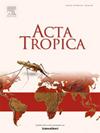The extent of parasite adaptive capability involved in erythrocyte invasion represents a significant challenge for the development of a Plasmodium falciparum vaccine. The parasite's geographical and populational origin may influence such adaptive behaviour; in vitro culture-adapted parasite strains are typically used for such studies. Previous studies have reported invasion phenotypes in strains from Africa and Asia and, to a lesser extent, from Latin America. This study was aimed at expanding the pool of characterised parasite strains from Latin America by describing the invasion phenotype of the P. falciparum Colombia Bogotá 2 (FCB2) strain. The FCB2 genome was sequenced and erythrocyte invasion ligand sequences were analysed and compared to other previously reported ones. RT-PCR was used for assessing Pfeba family erythrocyte invasion ligands and reticulocyte binding homologue (Pfrh) gene transcription. A flow cytometry-based erythrocyte invasion assay (using enzymatically-treated erythrocytes) was used for determining the FCB2 strain's invasion phenotype. The P. falciparum FCB2 genome sequence was analysed, bearing in mind that prolonged in vitro parasite culture may affect its genome sequence and, in some cases, lead to the deletion of certain genes; it was demonstrated that all erythrocyte invasion ligand gene sequences studied here were preserved. Comparative analysis showed that the target genome sequences were conserved whereas transcriptional analysis highlighted Pfebas and Pfrhs gene expression. Erythrocyte invasion analysis demonstrated that the FCB2 strain has a sialic acid-resistant invasion phenotype.


